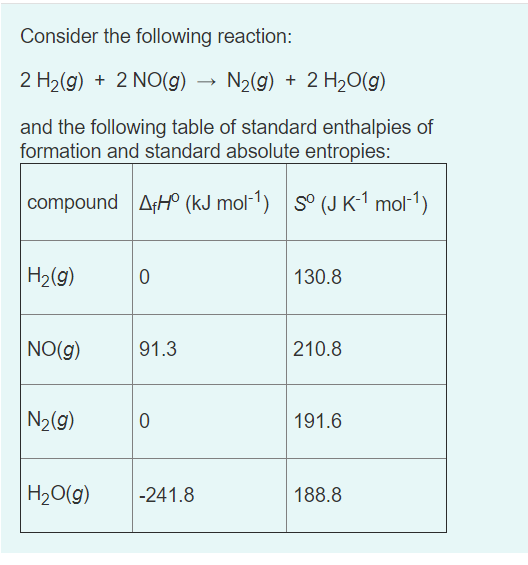Which of the following statements about the standard Gibbs energy change for the reaction, A,G° is best. O A;G° is the maximum amount of work that can be done when the reaction is at equilibrium. A;G° is the energy released by the reaction. O A„G° is the energy released by the reaction when the gases are at their equilibrium partial pressures. O A„G° is the maximum amount of work that can be done when all the gases are present each 1 bar.
Which of the following statements about the standard Gibbs energy change for the reaction, A,G° is best. O A;G° is the maximum amount of work that can be done when the reaction is at equilibrium. A;G° is the energy released by the reaction. O A„G° is the energy released by the reaction when the gases are at their equilibrium partial pressures. O A„G° is the maximum amount of work that can be done when all the gases are present each 1 bar.
Chemistry: The Molecular Science
5th Edition
ISBN:9781285199047
Author:John W. Moore, Conrad L. Stanitski
Publisher:John W. Moore, Conrad L. Stanitski
Chapter16: Thermodynamics: Directionality Of Chemical Reactions
Section: Chapter Questions
Problem 101QRT: Appendix J lists standard molar entropies S, not standard entropies of formation rS. Why is this...
Related questions
Question

Transcribed Image Text:Which of the following statements about the standard Gibbs energy change for the reaction, A;G° is best.
O A„;G° is the maximum amount of work that can be done when the reaction is at equilibrium.
O A,G° is the energy released by the reaction.
O A,G° is the energy released by the reaction when the gases are at their equilibrium partial pressures.
O A;G° is the maximum amount of work that can be done when all the gases are present each at 1 bar.

Transcribed Image Text:Consider the following reaction:
2 H2(g) + 2 NO(g)
N2(g) + 2 H20(g)
and the following table of standard enthalpies of
formation and standard absolute entropies:
compound AH (kJ mol-1) s° (J K-1 mol-1)
H2(g)
130.8
NO(g)
91.3
210.8
N2(g)
191.6
H20(g)
-241.8
188.8
Expert Solution
This question has been solved!
Explore an expertly crafted, step-by-step solution for a thorough understanding of key concepts.
Step by step
Solved in 2 steps with 2 images

Knowledge Booster
Learn more about
Need a deep-dive on the concept behind this application? Look no further. Learn more about this topic, chemistry and related others by exploring similar questions and additional content below.Recommended textbooks for you

Chemistry: The Molecular Science
Chemistry
ISBN:
9781285199047
Author:
John W. Moore, Conrad L. Stanitski
Publisher:
Cengage Learning

General Chemistry - Standalone book (MindTap Cour…
Chemistry
ISBN:
9781305580343
Author:
Steven D. Gammon, Ebbing, Darrell Ebbing, Steven D., Darrell; Gammon, Darrell Ebbing; Steven D. Gammon, Darrell D.; Gammon, Ebbing; Steven D. Gammon; Darrell
Publisher:
Cengage Learning

Principles of Modern Chemistry
Chemistry
ISBN:
9781305079113
Author:
David W. Oxtoby, H. Pat Gillis, Laurie J. Butler
Publisher:
Cengage Learning

Chemistry: The Molecular Science
Chemistry
ISBN:
9781285199047
Author:
John W. Moore, Conrad L. Stanitski
Publisher:
Cengage Learning

General Chemistry - Standalone book (MindTap Cour…
Chemistry
ISBN:
9781305580343
Author:
Steven D. Gammon, Ebbing, Darrell Ebbing, Steven D., Darrell; Gammon, Darrell Ebbing; Steven D. Gammon, Darrell D.; Gammon, Ebbing; Steven D. Gammon; Darrell
Publisher:
Cengage Learning

Principles of Modern Chemistry
Chemistry
ISBN:
9781305079113
Author:
David W. Oxtoby, H. Pat Gillis, Laurie J. Butler
Publisher:
Cengage Learning

Chemistry & Chemical Reactivity
Chemistry
ISBN:
9781133949640
Author:
John C. Kotz, Paul M. Treichel, John Townsend, David Treichel
Publisher:
Cengage Learning

Chemistry: An Atoms First Approach
Chemistry
ISBN:
9781305079243
Author:
Steven S. Zumdahl, Susan A. Zumdahl
Publisher:
Cengage Learning

Chemistry: Principles and Practice
Chemistry
ISBN:
9780534420123
Author:
Daniel L. Reger, Scott R. Goode, David W. Ball, Edward Mercer
Publisher:
Cengage Learning